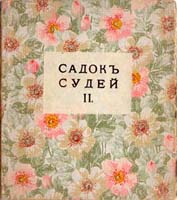|
Vladimir Mayakovskii (1893 - 1930) |
5589
|
|||
|
|
Sadok Sudei A trap for judges St. Petersburg: Zuravl, 1910 125 x 120 mm. 132 pages Edition: 300
5590
Sadok Sudei II A trap for judges II St. Petersburg: Zuravl, 1913 200 x 175 mm. 125 pages Edition: 800
|
A collection of texts and poems produced by David Burliuk. Contributor": D.Burliuk, V.Burliuk, E.Guro, V.Kamenskii, V.Khlebnikov, A.Khruchenykh, V.Maiakovskii and others. Illustrated with 9 lithographs by Vladimir Burliuk
The first half of the year 1910 was a time of immense activity for David Burliuk. He took part in almost every debate about painting and poetry, propagating modern art, not only in the capital but also in the provinces. The deep bond between poetry and art, many artists being master in one or both of these professions, was changing the conception of art in Russia. Whereas former classical rhythms were dictating poetry, now the sound was giving free reign. This anthology of poetry is central in the development of Russian Avant-garde book art. David Burliuk , the “father of the Russian Futurism ” introduced a new concept of book presentation. These publications were not meant to please the eye or the ear, but to provoke. In stead of chromolithography on costly paper the book was printed in black and white on cheap wall paper. The printing on wall paper had one disadvantage: the machines had to be cleaned often from the chalk of the paper. Although printed in an edition of 300, due to paying problems, only a few copies exist today.
Sadok sudei II is the sequel to the anthology of 1910. The name, an invention of the Poet Khlebnikov was kept. Again David Burliuk was producer and one of the main contributors. But now the book was published in a bigger format with more illustrations. There were now 3 lithograph by David and 2 by his brother Vladimir. Natalia Gontcharova and Michael Larionov had each two and Elena Guro 6 lithographs in the book. In this volume there is more of the propagation of the new art. The opening of the book is formed by an untitled manifesto that for the first time provided a detailed constructive program for the renewal of art in Russia. In the coarse woodcuts that David Burliuk referring to the steppes in which he grew up in youth. These are the first in his ‘horse-cycles’ characterized by fragmentation of the forms and a use of thick lines. It is a style that will mark Burliuk for several years.
References: Markov 1969 p. 22 Ex libris 1974, nr. 38 Compton 1978, p. 60 Bologna 1993, nr. 19 Munich 1993, nr. 19 Otaru, 1996, p. 21 Getty 1997, nr. 151 Lavrentiev 2000, p.13 Moma 2002, nr. 1 Nijmegen 2004, p. 51 Brussels 2005, nr. 9 Hellyer 2006, nr. 462 Khachturov 2009, p. 42 Moscow 2010 nr. 81 Eindoven 2013, nr. 1 Offenbach 2016, nr. 1 and 2 |
||

